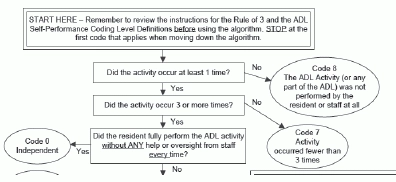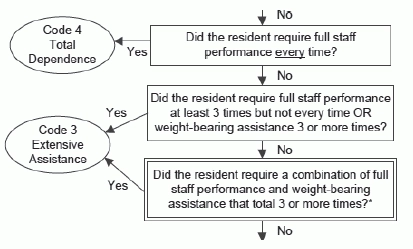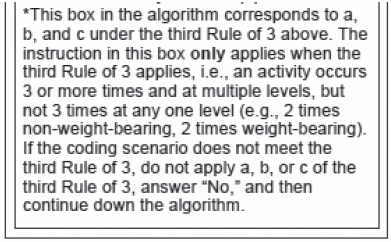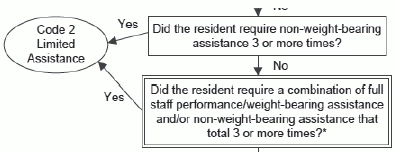Tip: Keep definitions, Rule of 3 text handy while using algorithm.
The October 2013 overhaul of the RAI Manual bestowed upon the MDS 3.0 a whole host of important changes, and among these revisions were several clarifications to item G0110 — Activities of Daily Living (ADL) Assistance. You also received a new ADL Self-Performance Algorithm tool. But many MDS Coordinators are unsure how exactly to use this new tool.
Caveat: Remember that the algorithm (found on page G-7 of the RAI Manual) is not a stand-alone tool, warned Mary Pratt, RN, MSN, with the Centers for Medicare & Medicaid Services (CMS) Center for Clinical Standards and Quality, in the March 20 provider update video. CMS created the algorithm “to assist facilities and augment all of the instructions for item G0110, including the ADL self-performance coding level definitions and the Rule of 3.”
And before you can even begin to use the ADL Self-Performance Algorithm, you must first understand the coding level definitions and the instructions for the Rule of 3 before using the algorithm, Pratt cautioned. When using the algorithm, you should also keep the coding level definitions and the full text for the Rule of 3 handy.
Understand the Algorithm Using an Example
One way to gain a better understanding of how to use the algorithm is to see its use in action while working through a coding scenario. In the provider update video, Lori Grocholski, MSW, LCSW, with CMS’s Center for Clinical Standards and Quality, uses this example to illustrate how to apply the ADL self-performance algorithm.
Example: Mr. N was admitted to the nursing home but on the second day, he transferred to the hospital. Mr. N received the following assistance for the dressing ADL during the seven-day look-back period. On the first day, staff provided weight-bearing assistance to once to lift Mr. N’s right arm into his shirt sleeves when dressing in the morning. That evening, he was independent when undressing and putting on his bedclothes. On the second day, the resident received non-weight-bearing assistance one time to button his shirt and full staff performance once to put his pants on after resting in bed in the afternoon.
Begin the Algorithm Process Here
The first box under “START HERE” asks whether the activity occurred at least one time. You would answer “yes” and move on to the box below, because the dressing ADL in the example occurred four times total. The box below asks whether the activity occurred three or more times. You would answer “yes” again, and then move on to the next box below.
This box asks, “Did the resident fully perform the ADL activity without ANY help or oversight from staff every time?” This does not apply “because there were three times where the resident required assistance and only one time where he performed the activity without any help,” Grocholski noted. So you would answer this question as “no” and continue moving down the algorithm.

The next box below asks, “Did the resident require full staff performance every time?” You would answer “no” to this as well because Mr. N indeed performed the ADL once without any assistance, with weight-bearing assistance and with non-weight-bearing assistance.
Moving on, the next box asks whether the resident required full staff performance at least three times but not every time, or weight-bearing assistance three or more times. “According to our ADL scenario, we have only one episode of weight-bearing assistance and one episode of full staff performance,” Grocholski pointed out. So you would answer “no” and continue down to the next box.
Keep Your Eyes Peeled for Double-Line Boxes
Important: “The next box is a double-lined box with an asterisk where we need to pay attention to the instructions within it,” Grocholski stressed. The box states, “Did the resident require a combination of full staff performance and weight-bearing assistance that total three or more times?”

Look here: The asterisk directs you over to the related paragraph under the instructions for the Rule of 3, Grocholski noted. The asterisk paragraph states: “This box in the algorithm corresponds to a, b, and c under the third Rule of 3 above.” The instructions go on to state that the instruction in the box applies only when the third Rule of 3 applies (i.e., an activity occurs three or more times and at multiple levels, but not three times at any one level). And if the coding scenario does not meet the third Rule of 3, do not apply sub-items a, b, or c of the third Rule of 3. Instead, answer “no” and continue down the algorithm.

But after reviewing this information, you would conclude that the example does apply to the third Rule of 3, Grocholski said. And although you would be able to combine the one instance of full staff performance and one instance of weight-bearing assistance, “that total would not equal three, so sub-item ‘b’ would not apply.” Therefore, the answer here is “no” and you would continue to the next box below.
Keep Going Until You Get an Answer
The next box asks, “Did the resident require non-weight-bearing assistance three or more times?” The answer here is also “no,” because he required this level of assistance only once, and you would move down to the next box.

This box asks whether the resident required a combination of full staff performance/weight-bearing assistance and/or non-weight-bearing assistance that totaled three or more times. “We already know from the prior double-line box that when we try to combine the episode of weight-bearing assistance with the episode of full staff performance, we only had two episodes of weight-bearing assistance,” Grocholski noted. “So we were not allowed to stop at sub-item ‘b’ of the third Rule of 3.”
Stop When You Find the First Correct Code
Your next step is to look at sub-item “c,” which is what this box in the algorithm refers to, Grocholski stated. “Even though we did not have enough episodes to total three weight-bearing episodes, we do have an additional episode that occurred at the non-weight-bearing level that we can consider here.”

If you add the single non-weight-bearing episode to the two weight-bearing episodes, you do get three episodes and this does meet the criteria outlined in sub-item “c,” Grocholski illustrated. “At this point in the algorithm, we would stop here, because this is the first code that applies to our scenario as we moved down this algorithm.”
Answer: Therefore, the code that the scenario meets and that corresponds to sub-item “c” is Limited assistance (2), Grocholski concluded.
